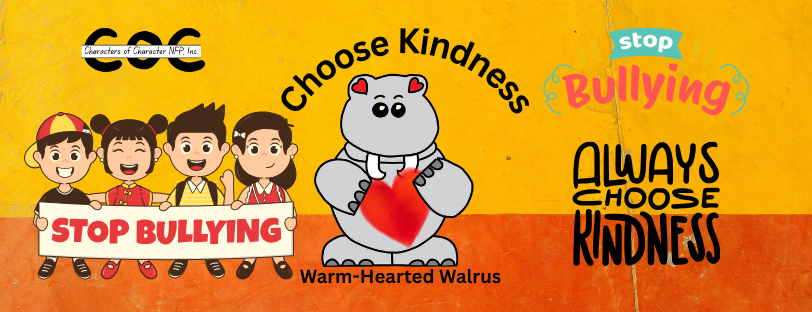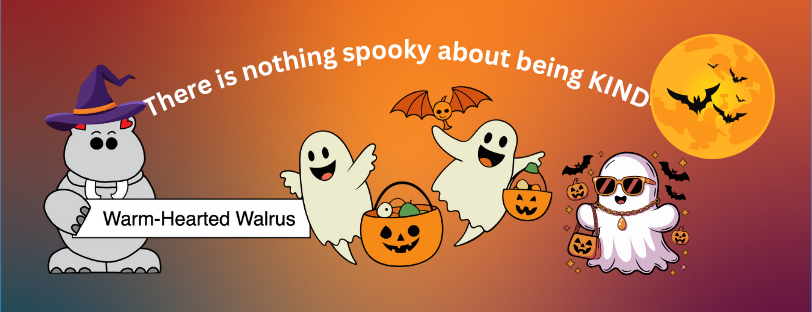No Bullying Month
October is National No Bullying Month. Personally, I’m saddened that there is a month to focus on such a topic. Bullying is NOT okay. While it’s been around forever, it does not make it right, make it easy or make it acceptable. Stop to ask yourself; “What is bullying?” and “Is my child a bully or a victim of bullying?” and “What can I do to help prevent or address the topic of bullying?” If you have never been bullied or are not aware that this actually is a big issue, please read more to learn how YOU can support others or help someone who is a victim or who the bully themself. To be honest, it’s not just our children who are bullies or being bullied, it’s in the workforce, families and in your community. Awareness is key and solutions are of the utmost need.
Our character Warm-Hearted Walrus has resources, activities, tips and lessons to help teach a child what bullying actually is.
These are a few reasons children bully based on child development research and if you stop to think about it, common sense:
Low Self-Esteem – Children who feel unsure of themselves or powerless may bully others to feel more important, confident, or in control. Our character Self-Esteem Elephant has resources to build confidence.
Learned Behavior – It’s a fact that children imitate adults and if they see aggressive behaviors at home, within peers or in the media they might believe that bullying is okay. We know that it is not! Our character Behavior Bear has resources. It’s important that you don’t just say to your child, BEHAVE, but take the time to talk about what it is, what it looks like, sounds like and the consequences of poor behaviors. If your child continues to use poor behavior they are not on a good path.
Desire for Control or Power – Bullying can be a way for kids to dominate or assert authority, especially if they feel powerless in other areas of their life. We see it all too often in adults that we know. Being respectful of others and one self is important and it’s important to teach our children that they can be leaders, but not by bullying. Earn respect and take responsibility of your actions. Our character Respectful Rabbit has resources and so does our character Responsible Rabbit.
Peer Pressure – Children may bully to fit in with a group, impress friends, or avoid becoming targets themselves. When I taught preschool this happened quite often. I always took the two children aside and switched their roles. The bully became the victim and it gave the children a better understanding of how they hurt their peers feelings or how it felt to be bullied. Give kids something to think about and something tangible to work with. This method never failed me!
There are other reasons why a child feels bullied or why they bully, for example, lack of social skills or empathy as they have a difficult time understanding others feelings or how to resolve conflicts in a healthy way. Some children may simply seek attention, even if it’s in a negative way, bullying.
When bullying goes undetected, children believe it’s acceptable or okay to behave this way. It’s NOT! If you’re dealing with your own child being a bully, here are some things to think about:
Are your child’s needs met? There might be something that is frustrating them and they act out for affection or validation. Are their emotional needs being met. A simple discussion opens up many conversations and they will express what they feel and you can help them figure them out. Do not dismay them, they may seem petty to you but they mean a lot to your child. Hence, acting out.
Environment, if your child is exposed to harsh discipline, lack of supervision or exposure to conflict (arguments) they may develop bullying behaviors. While an argument at times in inevitable, show your child how you talk things out and come to a solution or compromise and help them to develop coping skills.
While no parent wants to learn that their child is a bully or being bullied, we need to stop to be aware and to address this topic. Teaching our children at an early age is usually better, however as our children learn and grow it’s important to have open communications, build trust and be a positive role model. This is the best lesson you can provide to your child, in my opinion.
Click here for our Halloween coloring pages and blog post.
These are some ideas to help stop bullying before it starts, both at home and at school.
Early Teaching helps a child to recognize and name their emotions.
YOU are a role model, be respectful of others and yourself. Children are listening and watching you.
Build Confidence and self-esteem in your child by encouraging their interests and talents and feel capable of an accomplishment.
Encourage positive friendships where kids play and work together and problem solve respectfully.
Keep communications open, never make your child feel they can not come to you with questions or concerns. Keep eye contact.
Be clear when establishing the rules at home and at school.
There should be consequences for bullying. Build expectations about being kind and respectful and make sure that children understand that bullying is not cool, not acceptable, not funny and never welcomed at home or in school. Be fair with the consequences, not harsh but perfectly clear that it is not okay to bully.
Some may disagree, but I believe that positive reinforcement or a certificate is a great reward to good character, for trying, for doing the right thing, even when nobody else is looking. This helps to build a firm foundation for a child to develop strong civic values, it helps them to discover their own emotions and become empathetic to others. Here is a blog with certificates of achievement! No harm in building character in our children and youth!!

